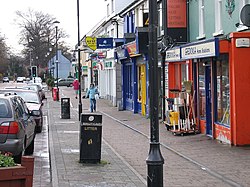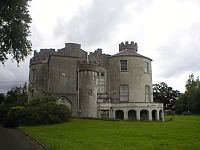Shankill, County Dublin
| Shankill Irish: Seanchill | |
| County Dublin | |
|---|---|
 Shankill | |
| Location | |
| Grid reference: | O249220 |
| Location: | 53°13’34"N, 6°7’26"W |
| Data | |
| Population: | 14,257 (2016) |
| Postcode: | D18 |
| Dialling code: | 01 |
| Local Government | |
| Council: | Dún Laoghaire–Rathdown |
| Dáil constituency: |
Dún Laoghaire |
Shankill is a village in County Dublin, in the south-east of the county close to the border with County Wicklow. It had a recorded population of 14,257 at the 2016 census.
The name Shankill is believed to derive either from the Irish Sean-Chill, meaning Old Church, or Sean-Choill, meaning Old Wood.
The centre of Shankill Village today consists primarily of the main street with shops, cafés, a public house, a post office, credit union and other retail outlets.
To the north of Shankill is Killiney and, to the south, across the county border in County Wicklow, is the town of Bray.
Contents
History
Middle Ages
Shankill holds a number of antiquities, including ráths and cromlechs. Around 1230, there were forests that were cleared under the orders of the then owner of Shankill, the Archbishop of Dublin. Courts for serious crimes in the style of assizes were conducted at Shankill during this period. To keep the native Gaelic clans out, fortified gates protected parts of the townland.
The manor of Shankill was overrun by the native Irish and completely destroyed a century later. In response to these incursions, a large garrison was re-instated. The Irish were restrained from entering and the land was eventually re-let as grazing land.
The Lawless family features prominently in the history of Shankill. In 1408, family members took control of the seigniory of Shanganagh and, by 1480, several branches of the family were residents of Shankill.
Between 1400 and 1600, a number of fortified structures - whose remains can still be seen to this day - were built: Shankill Castle, Shanganagh Castle and a strong house known locally as Puck's Castle. The Walsh family, which came to prominence in the 16th century, built several further defensive structures in Shankill.
Modern Period
From 1640 onwards, the native Irish were subdued in a series of confrontations, leading to greater agricultural use of the lands. Around this time, Shankill was absorbed into the parish of Rathmichael.
The Walshes quit the lands of Shankill primarily due to the Cromwellian Act of Parliament which redistributed landowners and tenancies. After this, the Lawless families regained possession for the third time of lands around Shankill. The last Lawless died in 1795, whereupon the lands became the possession of the third Sir William Domvile, resident of nearby Loughlinstown House. The Domvile family had been granted the lands surrounding Loughlinstown under the Restoration.
19th century
Shankill and Rathmichael were the property of Sir Charles Compton William Domvile (1822–1884). Domvile was known as an uncompromising and ruthless landlord and sought to change the usage of land from the smallholdings that existed at the time of his inheritance of the estate.
At this time Shankill was a rural village, but Domvile intended to build grand Georgian-style housing developments, squares and streets to gentrify the area, thereby making it attractive for wealthy Dublin city-based professionals to live in.
During Domvile's time, new roads and streets were laid out, as well as water mains which feed a relief tank from Vartry Reservoir, continuing on to Stillorgan reservoir.
However, Domvile was an impetuous man and acted unreasonably with his tenants and prospective buyers of estates on his holdings. His personal debts mounted as a result of his financing two large estates at Shankill and Santry, ultimately resulting in his bankruptcy.
The net outcome of Domvile's actions was to halve the population of Shankill and Rathmichael during the 1860s. He evicted over 100 tenants, during a period of grinding poverty, and many were forced to re-negotiate their tenancies at usurious rates. Many of the evicted ended up in the local workhouse, the Rathdown Work Union, which is now the site of Loughlinstown Hospital.
A landowner with holdings adjacent to the Shankill townland, Benjamin Tilly, granted quarter-acre holdings to some of the evicted tenants. Tilly's land straddled the townland border into Shanganagh, and thus the new holdings along the Shanganagh Road became known as 'Tillystown'. In 1871, there were over 60 houses, and around the start of the 20th century, this village became known as Shankill proper.
In 1911, a tract of land to the west of Shankill, known as 'New Vale', was developed as labourers' cottages.
20th, 21st centuries
Shankill initially comprised large agricultural tracts broken into smallholdings for tenant farmers, and larger, grander estates with fine country houses, many of which still exist today. Large housing estates - of varying size and quality - have been built on many of these estates. Recently, additional tracts of land have been sold to developers who have built higher-density housing than the larger-plot housing estates constructed in the 1970s.
Churches
- Church of Ireland:
- Crinken Church
- Rathmichael Church
- Roman Catholic: St Anne's
Sights about the village
There are several antiquities in the area, including ruined churches and standing stones. The ruins of several castles and defensive-type structures remain, including Puck's Castle, Shankill Castle, Shanganagh Castle and a Martello Tower.
Some houses of architectural note include Clontra—a coastal Gothic mansion near Corbawn Wood and Quinn's Road—Crinken Castle House, Crinken, and Shanganagh House, an imposing mansion now surrounded by local authority housing estates. Clontra was built for Dublin barrister James Anthony Lawson QC (later Attorney General of Ireland, Judge of the High Court and Privy Councillor) and designed by eminent 19th-century architects Sir Thomas Newenham Deane and Benjamin Woodward in their trademark Italian mediæval style. They are better known for their work on the Kildare Street Club and the museum building at Trinity College Dublin. The local library is itself of note, formerly a courthouse built in the Victorian style of granite and mock Tudor features. There are also some follys such as a mock round tower built of red brick in the Castle Farm Farmyard.
Traces of Dublin's industrial heritage remain, in particular, the lead-mine chimney at Ballycorus. Other features of note include the 'upside down' houses by the Harcourt Street railway line bridge, which was the site of the original post office, and has its guest rooms downstairs, and its kitchen and living room upstairs. Shankill was accessible via the original Kingstown-Bray train line, which is now five metres from the sea in some places. A coastal wall was built from Killiney to Bray to try to stop the erosion, traces of which can still be seen along the beach. The mediæval village of Longnon was sited some 200 yards east of Quinn's Road beach but was completely obliterated by coastal erosion.
The Ballycorus Leadmines are the site of a lead ore smelter, a mile-long stone flue and a granite chimney on Carrickgollogan hill, which is visible from much of south-east Dublin.
Dorney Court, originally called Clare Mount, was built about 1832. This fine house was demolished in 1984. Its site is now that of Shankill Garda Station. The grounds still contain a few Sequoia and Scots pine trees following the felling of many of them in 1984.
Clonasleigh, a house replaced by Shankill Shopping Centre (now upgraded and re-opened) was lived in by Frederick W. Meredith, once President of the Law Society, in the early 1900s. The name has been retained locally in Clonasleigh, a road with 16 houses, off Corbawn Lane, located close to the original house.
Clontra is a Gothic mansion designed by Deane and Woodward, 1860, interior murals by John Hungerford Pollen. On 15 acres of parkland by the coast, adjacent to Corbawn Wood estate.[1]
Other noteworthy houses and buildings include:
- Ferndale House, in an estate on several acres: seat of David Plunket, 1st Baron Rathmore.
- Mullinastill House, a former mill house, and the set for several film scenes.
- Old Harcourt Street line, a former railroad running from Dublin to Bray; closed in 1958.
- A spur line at Tyrell's land to the main Dublin-Bray line. Closed in 1915.
- Rosedale and Locksley: twin Victorian country houses, built by Guinness master brewer Perry in early 1856.
Puck's Castle
Puck's Castle is a a fortified house, was built in the late 16th century. It provided a refuge in 1690 for King James II and his army fleeing the Battle of the Boyne. One explanation for its name is that a ghost or puca inhabited the castle.[2] In June 1867 the daughter of a local Englishman disappeared near the castle. Jane Eleanor Sherrard, daughter of Henry and Margaret Sherrard left her nearby home to pick flowers for the dinner table. When she failed to return home that evening the police were notified and a widespread search was conducted. The last confirmed sighting of Jane was by the local postman, who reported to have seen her picking flowers at the foot of the castle's northern wall. To this day the circumstances surrounding her disappearance remain unknown.
Shanganagh Castle
Shanganagh Castle, near Mill Lane, was built in 1408 by the Lawless family and inhabited by their descendants until 1763, the castle was left in ruins by a fire in 1783.
During the late 18th century, a mansion of the same name was rebuilt on extensive lands at the border of Shankill with County Wicklow. It was used as an open prison for juveniles between 1969 and 2002.[3]
Shanganagh House
Shanganagh House, later called Shanganagh Park, is a Georgian-era mansion built in about 1823 for William Hopper. Later residents included the Darcy brewing family and racehorse breeder Frank Field. It was compulsorily purchased by Dublin County Council in 1970; it now serves as a community centre and is surrounded by late 1970s council houses.[4]
Shankill Castle
Built by Archbishop Henry de Loundres in 1229; Shankill Castle is also the site of the ancient Shankill church. It is one of the oldest surviving structures in the area.[5][6]
Rathmichael Church
Rathmichael Church was commissioned by Charles Domvile in 1860, designed by Benjamin Woodward, in the Hiberno-Romanesque style. The Domviles had their own high-backed chairs, behind red velvet curtains.
Pictures
Sport and leisure
- Bowling: Shankill Bowling Club
- Football:
- Shankill FC
- Shanganagh Cliffs FC
- Tennis: Shankill Tennis Club[7]
The trailhead of the Dublin Mountains Way, a long-distance walking route, a 27-miles trail across the Dublin Mountains between Shankill and Tallaght begins at Brady's pub on the main street.
Outside links
| ("Wikimedia Commons" has material about Shankill, County Dublin) |
References
- ↑ "Clontra, National Inventory of Architectural Heritage". Buildingsofireland.ie. http://www.buildingsofireland.ie/cgi-bin/viewsurveyresults.cgi?siteid=2560.
- ↑ Pucks Castle, brief history & photos Template:Webarchive
- ↑ "Shanganagh Castle (18th century), National Inventory of Architectural Heritage". Buildingsofireland.ie. http://www.buildingsofireland.ie/cgi-bin/viewsurveyresults.cgi?siteid=2556.
- ↑ "Shanganagh House, National Inventory of Architectural Heritage". Buildingsofireland.ie. http://www.buildingsofireland.ie/cgi-bin/viewsurveyresults.cgi?siteid=2557.
- ↑ "Shankill Castle, National Inventory of Architectural Heritage". Buildingsofireland.ie. http://www.buildingsofireland.ie/cgi-bin/viewsurveyresults.cgi?siteid=2541.
- ↑ Shankill Castle, brief history Template:Webarchive
- ↑ Shankill Tennis Club







